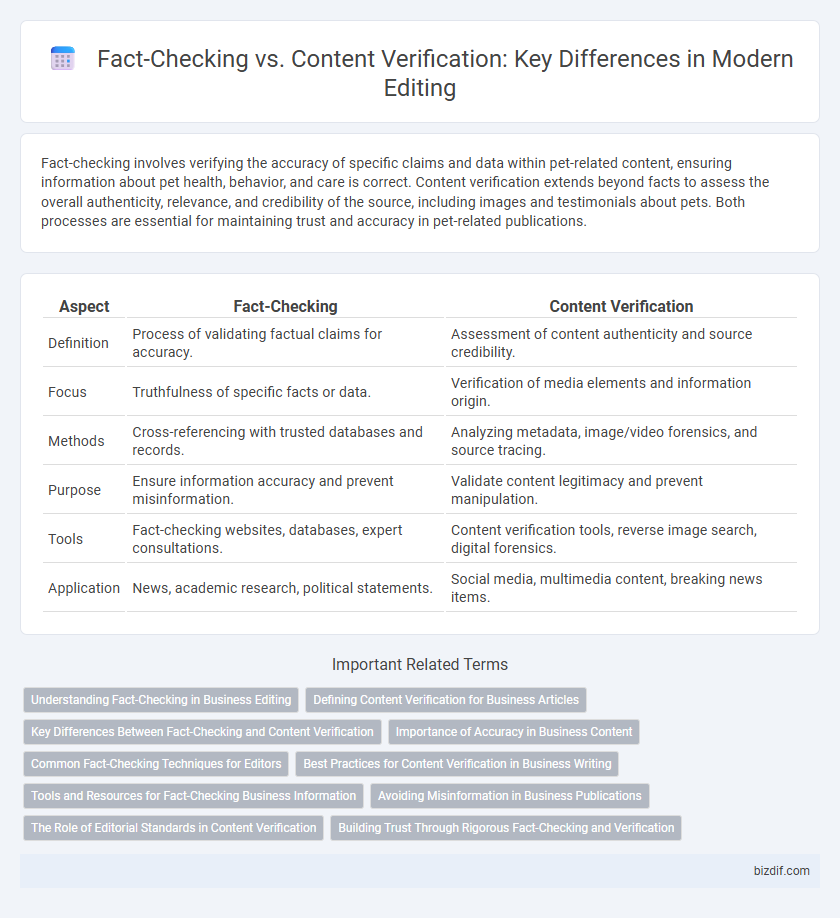Fact-checking involves verifying the accuracy of specific claims and data within pet-related content, ensuring information about pet health, behavior, and care is correct. Content verification extends beyond facts to assess the overall authenticity, relevance, and credibility of the source, including images and testimonials about pets. Both processes are essential for maintaining trust and accuracy in pet-related publications.
Table of Comparison
| Aspect | Fact-Checking | Content Verification |
|---|---|---|
| Definition | Process of validating factual claims for accuracy. | Assessment of content authenticity and source credibility. |
| Focus | Truthfulness of specific facts or data. | Verification of media elements and information origin. |
| Methods | Cross-referencing with trusted databases and records. | Analyzing metadata, image/video forensics, and source tracing. |
| Purpose | Ensure information accuracy and prevent misinformation. | Validate content legitimacy and prevent manipulation. |
| Tools | Fact-checking websites, databases, expert consultations. | Content verification tools, reverse image search, digital forensics. |
| Application | News, academic research, political statements. | Social media, multimedia content, breaking news items. |
Understanding Fact-Checking in Business Editing
Fact-checking in business editing involves verifying the accuracy of reported information, such as financial data, dates, and key figures, ensuring credibility and preventing misinformation. It requires thorough cross-referencing with reliable sources, including official reports, market analyses, and expert statements. Effective fact-checking enhances stakeholder trust and supports informed decision-making within the business environment.
Defining Content Verification for Business Articles
Content verification in business articles involves systematically confirming the accuracy, authenticity, and reliability of all information, sources, and data presented. This process ensures that every fact, statistic, and quotation aligns with credible evidence, thereby maintaining journalistic integrity and enhancing reader trust. Distinct from fact-checking, content verification encompasses broader validation techniques including source authentication and contextual accuracy, essential for producing authoritative business content.
Key Differences Between Fact-Checking and Content Verification
Fact-checking involves rigorously validating the accuracy of specific claims or data points within a text by cross-referencing reliable sources and expert opinions. Content verification encompasses a broader scope, including the authentication of images, videos, author credentials, and publication context to ensure overall information integrity. Key differences lie in fact-checking's focus on factual accuracy versus content verification's emphasis on confirming the authenticity and trustworthiness of all multimedia elements and sources.
Importance of Accuracy in Business Content
Fact-checking ensures the factual correctness of specific data points such as statistics, dates, and names, whereas content verification assesses the overall authenticity and credibility of the source material. Maintaining accuracy in business content prevents misinformation that can damage brand reputation and mislead stakeholders. Precision in facts strengthens trust, supports informed decision-making, and enhances professional integrity within competitive markets.
Common Fact-Checking Techniques for Editors
Editors employ common fact-checking techniques such as cross-referencing information with credible sources, verifying data through official records, and consulting subject matter experts to ensure accuracy. They also analyze the provenance of content by assessing the reliability of original sources and confirming dates, names, and statistics. Digital tools like plagiarism checkers and automated fact-checking software enhance the efficiency and thoroughness of content verification processes.
Best Practices for Content Verification in Business Writing
Effective content verification in business writing involves cross-referencing facts with credible sources such as official reports, academic publications, and verified databases to ensure accuracy. Employing digital tools like plagiarism checkers and fact-checking software enhances the reliability of data and prevents misinformation. Maintaining a rigorous verification process strengthens the credibility of business communications and supports informed decision-making.
Tools and Resources for Fact-Checking Business Information
Effective fact-checking of business information relies on tools like Dun & Bradstreet for company data, Hoovers for comprehensive business profiles, and OpenCorporates for corporate registries. Utilizing resources such as the Better Business Bureau and official government databases ensures the verification of company legitimacy and compliance. Employing these specialized platforms enhances accuracy and credibility in editorial content related to business facts.
Avoiding Misinformation in Business Publications
Fact-checking involves verifying the accuracy of specific claims and data points in business publications, ensuring all referenced statistics and quotes are authentic. Content verification expands this process by confirming the overall reliability, sources, and context of the information presented. Both practices are crucial for avoiding misinformation, maintaining credibility, and protecting a company's reputation in competitive markets.
The Role of Editorial Standards in Content Verification
Editorial standards play a critical role in content verification by establishing clear criteria for accuracy, reliability, and authenticity in published material. These guidelines ensure that all information undergoes rigorous scrutiny, reducing the risk of misinformation and enhancing trustworthiness. Consistent adherence to editorial standards supports a systematic approach that distinguishes fact-checking from broader content verification processes.
Building Trust Through Rigorous Fact-Checking and Verification
Fact-checking ensures the accuracy of specific claims by cross-referencing reliable sources, while content verification assesses the authenticity and origin of the entire material. Rigorous application of both methods enhances credibility, reduces misinformation, and fosters audience trust. Integrating advanced verification tools and transparent processes strengthens editorial standards and promotes accountability.
Fact-checking vs Content Verification Infographic

 bizdif.com
bizdif.com